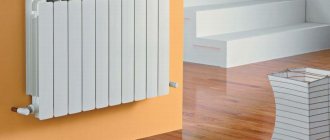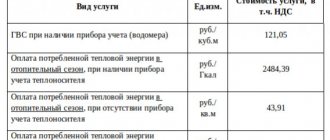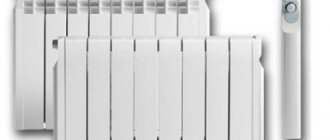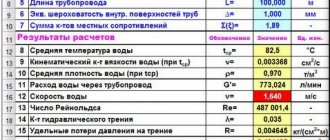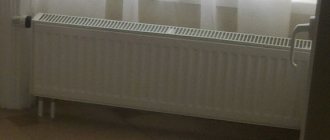Calculation of boiler thermal power
For example, the area of a heated cottage is known to be 250 m²; it is required to heat the cottage and provide hot water for a family of 3 people.
According to Russian standards, with a ceiling height of up to 2.5 m, 1 kW is required to cover heat losses from 10 m².
Therefore, the required boiler power is: ~25 kW for heating and another +25% -30% for hot water.
Nk = 25+30% = 32.5 kW of useful power we will need to provide heating and hot water.
To heat a house, it is necessary to select a boiler with the required thermal output, this should be done by a specialist in this field with the support of appropriate calculations. However, in order to first get acquainted with the prices of boilers for heating a house that run on solid fuel (coal, firewood), we can simplify the calculations and determine for ourselves the approximate power of the boiler.
First of all, you must decide whether the boiler will be used only for space heating, or also for heating hot water.
If a solid fuel boiler is used only for heating the premises of the house, its power should be equal to the heat loss of the house. The following loss ranges are assumed for houses, depending on construction technology:
120 - 200 W / square meter - houses with thermal insulation
90 - 120 W / square meter - old houses with thermal insulation
60 - 90 W / square meter - modern houses with good insulation, tight windows and doors
Boiler power is calculated using a simple formula:
Boiler power [kW] = heat loss * area * 1,000
For example, for a new house with an area of 160 square meters, the boiler power should be 12-14 (kW).
Boiler power for space heating and water heating
In the case where a solid fuel boiler will also be used to heat water, its power must accordingly be greater to meet the demand for additional heat. Using a single-function boiler that heats the water in the boiler, you can use the following formula to calculate the time required to heat the entire boiler:
Time [s] = specific heat capacity of water * temperature difference * mass of water) / boiler power
The specific heat capacity of water is constant and amounts to 4.2 kJ / (kg * K), we can take 40 degrees as the temperature difference, the weight of water for 200 liters is 200 kg. Assuming the boiler power is 15 kW, the calculations will look like this:
Time [s] = (4.2 * 40 * 200) / 15 = 2240 seconds or 37 minutes. This is the time required to heat water from an initial temperature of 10 degrees.
Usually, however, the water in the boiler is already at some temperature, since the boiler is operating all the time. In this case, for example, if suddenly we use 100 liters of water (the full capacity of the bathroom, when mixing water with cold water), then the heating time for the water missing in the boiler would be 16 minutes. In this case, a power of 15 kW is sufficient.
In conclusion, in the case of a modern house with a living area of 160 square meters, with a water heating boiler with a capacity of 200 liters. A 15 kW boiler will be sufficient.
www.wirbel-rus.ru
The heat in the apartment can be felt and calculated
In the cold months of the year, the question of how to provide space heating and retain existing heat always becomes relevant. In the autumn-spring period, when central heating is still or no longer working, or for additional heating in winter, the most common way to maintain the optimal temperature is to use various types of heating devices.
And in order to use energy rationally, you need to be able to calculate the power of the heater and make the right choice of its type for your home.
Thermal power table
Heaters: look and choose When purchasing a heating device, attention is paid mainly to two indicators - power and type of heater. First, based on the existing dimensions and characteristics of the heated space (building design, level of thermal insulation, purpose and location of the room), the minimum power that provides space heating is calculated, and then the type of heater is selected (mainly based on the price-quality ratio).
Proper consideration of these two factors (power and type) always ensures the correct calculation of room heating.
House heating scheme.
There are several methods for calculating the required thermal power for heating a room. Let's look at the two most common ones available for independent use:
- method of heating one cubic meter of housing. Most often used when calculating the number of radiator sections in standard-built houses (without special energy-saving measures);
- method taking into account indoor and outdoor air temperatures. It is standard for calculating the required thermal power of a separate heater (oil, infrared and others).
Let's look at each method with an example.
- So, let’s calculate how many sections (ribs) of a cast iron battery (domestic production) need to be taken to heat a room with an area of 18 m2 and a height of 2.7 m to +20 degrees. First, we select the brand of cast iron radiator (for example, M-140-AO) based on heat transfer per 1 m3 from the table.
| Radiator type | Heating surface, m2 | Heat transfer of one section, kW (+20°) |
| M-140-AO | 0,299 | 0,175 |
| M-140-AO-300 | 0,170 | 0,108 |
| M-140 | 0,254 | 0,155 |
| M-90 | 0,200 | 0,130 |
| RD-90s | 0,203 | 0,137 |
Next, let's calculate the volume of the room: volume = area x height = 12 x 2.7 = 32.4 m3. According to the climatic conditions for the European part of Russia, Belarus, Ukraine and Moldova, heating one cubic meter of air to +20° in a typical panel house (from the table) requires approximately 41 W (0.041 kW) of thermal power.
| House type | Recommended amount of thermal energy, kW/m3 |
| Typical panel | 0,041 |
| Brick, with wall insulation (foam plastic, mineral wool) | 0,034 |
| Modern, complies with building regulations | 0,020 |
Now we will show the calculation of the optimal recommended thermal energy for a room: 32.4 x 0.041 = 1.3284 kW. Required number of radiator sections: 1.3284 / 0.175 = 7.59 fins, after rounding we get 8 sections of cast iron battery.
https://youtu.be/SB5xcnY1sdY
The same calculation for a brick house would show us 7 sections (Photo 1). Note that depending on the location of the room (corner apartment), the temperature of the water in the system and other factors, the number of heater fins may change (usually upward). Therefore, it is always recommended to add 15-20 percent to the calculated number
Return to contents
Now let's consider calculating the heating power taking into account the desired temperature difference using the formula: V x T xk = kcal/hour, where:
- V is the volume of the heated room;
- T is the difference between two air temperatures, outside and inside the room;
- k is the coefficient of heat loss (or thermal insulation). Ranges from 4.0 (for buildings with very poor thermal insulation) to 0.6 (high thermal insulation);
When making calculations, it is necessary to take into account the formula for converting kilocalories to kW: 1 kW = 860 kcal/hour.
From the first example, for a cast iron battery, we take the volume of the room V = 32.4 m3. Let the temperature inside be +20 degrees and outside -12 degrees. Then the temperature difference T = 20 - (-12) = 20 + 12 = 32.
| Thermal insulation coefficient, k | Construction and insulation of the room |
| 3,0 — 4,0 | There is no thermal insulation. Simple wooden structures. |
| 2,0 — 2,9 | Little thermal insulation. Single brickwork. |
| 1,0 — 1,9 | Average thermal insulation. Double brickwork. |
| 0,6 — 0,9 | High level of thermal insulation. Double insulated walls. The floor, roof and windows are insulated. |
For our example, let's take the coefficient k = 2.5. The required thermal power is 32.4 x 32 x 2.4 = 1044.576 kcal/hour or 1044.576 / 860 = 1.21 kW. Thus, to heat our room at the specified temperature, we will need a heater with a power of at least 1.2 kW. But it’s better to take a reserve, for example, 1.5 kW in case it gets colder outside.
This is how, without specialists, by making a simple calculation, you can determine the power of autonomous heaters of various brands and models (Photo 2).
Note that on the Internet there are many online programs that calculate the minimum required power of heating devices, taking into account a large number of parameters (climatic, architectural for the house, location of the apartment, individual preferences and others).
1poteply.ru
Example:
Volume of the heating room (width 4 m, length 12 m, height 3 m): V = 4 x 12 x 3 = 144 m3. Outside temperature -5°C. Required internal temperature +18°C. Temperature difference ΔT = 18°C - (-5 C) = 23°C. k = 4 (low insulated building). Power calculation: 144 m3 x 23°C x 4 = 13,248 kcal/h - the required minimum power. Assumed: 1 kW = 860 kcal/h; 1 kcal = 3.97 WTU; 1 kW = 3412 WTU; 1 BTU = 0.252 kcal/hour. Total: 13,248 kcal/h / 860 = 15.4 kW - the required minimum power in kW. Now you can select the heater type.
Types of electric heaters, their differences from each other
Electric heaters come in different types, each of which has its own advantages, disadvantages, principle and speed of action.
Let's list some of them:
- Heat fan - this device is somewhat reminiscent of a regular fan, but in front of its blades there is an incandescent spiral, which provides heating to the part of the room to which the air flow is directed. Although a fan heater is quite effective, it is not designed to constantly heat a room. A significant disadvantage of such a device is the short-term effect of its impact on the environment.
- The principle of operation of a ceramic heater is very similar to a fan heater, only ceramic plates act as a heater. Such models run on gas and from electricity; they are floor-mounted, wall-mounted, and even table-mounted. The main advantage of a ceramic heater is the preservation of humidity in the room.
- An oil-type radiator copes with heating the air in a very short time, but you should not purchase it if there are animals or small children in the house, since both of them risk getting burned. Such a device is considered not the most economical option - it consumes a lot of electricity.
- Electric models heat the air to the desired temperature quickly enough, and cool down slowly. The operating principle of these devices is based on convection. At the bottom of the device there are parts that suck in air; heating occurs due to the operation of a heating element - a tubular electric heater, the area of which directly determines the volume of heated gas. That is why heating elements are often produced with a ribbed surface. The advantage of a convector over an oil heater is that the temperature of the coolant rises at a faster rate, which means you don’t have to wait until the room gets warmer. In addition, these devices are much more compact. Wall-mounted models are especially popular.
- Infrared heater. The operation of devices of this type is based on electromagnetic radiation - in this case, first objects exposed to the waves are heated, and then the air itself. The structural elements of the device are also heating elements. Another option is open coils, sometimes protected by quartz tubes, or metal mesh, plastic panels with holes, or carbon coating. In rooms, the heater is protected by transparent partitions or metal mesh. Infrared heaters come in different types. Depending on the wavelength, they are divided into short-wave, medium- and long-wave, on the energy source - electric, gas, diesel and water, on the installation method - mobile and stationary.
Calculation of the number of sections of heating radiators: how many and what power batteries are needed in the house
In our lives, each of us has replaced radiators at least once or seen other specialists do it. If the end result matters to you, then you will have to calculate the number of sections of heating radiators.
In old houses, the number of radiator sections for heating the room does not always correspond to the required quantity.
It is also possible that the building was undergoing major renovations, as a result of which additional windows could appear in the room, which would affect the heating properties of the previously installed heating equipment.
Correct calculation of radiator sections will avoid heat loss in the room.
The main quantity is the area of the room that needs heating. Correct calculation of heating radiators will make it possible to accurately determine the number of sections that will provide the required heat transfer in a given room.
Power calculation will be useful for both main heating and additional heating. Building codes suggest that heating one square meter of living space requires 100 watts of power.
The formula for calculating the number of radiator sections will look like this:
S x 100/P = N
- where N is the number of required sections (the desired value);
- S is the total area of the heated room, which is measured in square meters;
- P is the power of radiator battery sections, which is measured in W (Watt).
Let's look at a specific example.
If you need to purchase heating radiators, then you can calculate how many sections are required, provided that one section produces a power of 170 watts, and the area of the room that needs to be heated, for example, is thirty square meters.
Calculation of sections
We get the result using the formula:
30 x 100/170 = 17.64 - this means that if you require optimal temperature conditions in a room with a total area of thirty m2, then for this you need to install 18 battery sections.
For corner rooms (the room is located on the corner of the house), in the above formula it is necessary to apply a multiplying factor, which is equal to 1.2. Let's make a new recalculation for a corner room with a total area of thirty m2:
18 x 1.2 = 21.6 - this calculation of the thermal power of the radiators showed that to heat a corner room with an area of thirty m2, 22 sections of radiators will be required.
There is another important point in the calculation - the height of the ceiling. High ceilings require the use of more powerful heating sources for the living space.
Thus, if the ceilings of the building are more than three meters high, then the final formula will look like this:
S x H x 40/P = N
- where N is the number of required sections (the desired value);
- S is the total area of the heated room, which is measured in square meters;
- H – ceiling height in the room, this value is measured in meters;
- P – power of one radiator section, measured in W (Watt).
Batteries must be installed under all windows in the room. This condition prevents cooled air from entering the heated room from outside.
This placement of radiator batteries will prevent fogging of the window glass. Modern double-glazed windows and the general condition of the room’s thermal insulation allow you to save a little on the number of sections of radiator batteries.
Another important fact when heating a building is the heating equipment itself.
In addition to accurately calculating the number of required radiator sections, there is a simpler, but at the same time approximate option for determining their optimal number.
It must be borne in mind that in addition to accurately determining the number of sections, the correct location of the radiator is important. Click to enlarge.
Based on the fact that sections of radiator batteries are mass-produced, they have standard sizes, so it can be calculated that with a standard ceiling height (up to three meters), one heating section of a radiator battery can heat 1.8 m2 of living space.
Thus, for a room with a total living area of thirty m2, you will need 30/1.8 = 16.6.
This means that to heat 30 square meters of living space you will need at least 17 sections, and this is provided that one section has a power of at least 50 kW, otherwise such a calculation of heating sections will have a large error.
In a standard room that has one outer wall with one window, the number of heating radiator sections can be calculated based on the fact that one kilowatt of power will be enough to maintain a comfortable temperature regime for ten square meters of the area of the heated room.
In the case where the room has two walls on the outside, to heat the same number of square meters you will need 1.3 kW.
Before choosing a radiator, it is necessary to determine the location of its installation, because the size of the heating device will depend on this.
The distance from the floor to the radiator must be at least 15 centimeters, and from the riser to the junction with the radiator battery must be at least 30 centimeters.
Volumetric calculation
This method of calculating the required number of sections involves the use of the following values:
- room length;
- room height;
- width of the room.
This calculation method is therefore called “volumetric” calculation of the number of sections of heating batteries. One section of a radiator battery with a power of 200 W can heat five square meters of room.
Dividing the volume of the room by five, we get the desired value. These calculations assume the average power of just one section, which according to standards ranges from 120 to 200 kW.
In order to avoid errors, about 10 - 20% of the reserve should be laid down before purchasing equipment.
ultra-term.ru
Accounting for thermal insulation
Thermal insulation plays a significant role in calculating the required power. For example, a 2 m layer of mineral wool will significantly reduce heat loss, λ = 0.06 (for the above parameters):
Q= 0.06*30*40/0.2 = 360 (W) = 0.36 (kW).
When calculating floor heat loss, it is taken into account that the soil has an initial temperature of about 5 degrees Celsius.
If the room is insulated, then an average of 3 to 5 kW will be needed to compensate for heat loss. You can make your own calculation using the example given; data on specific materials can be easily found in reference books.
